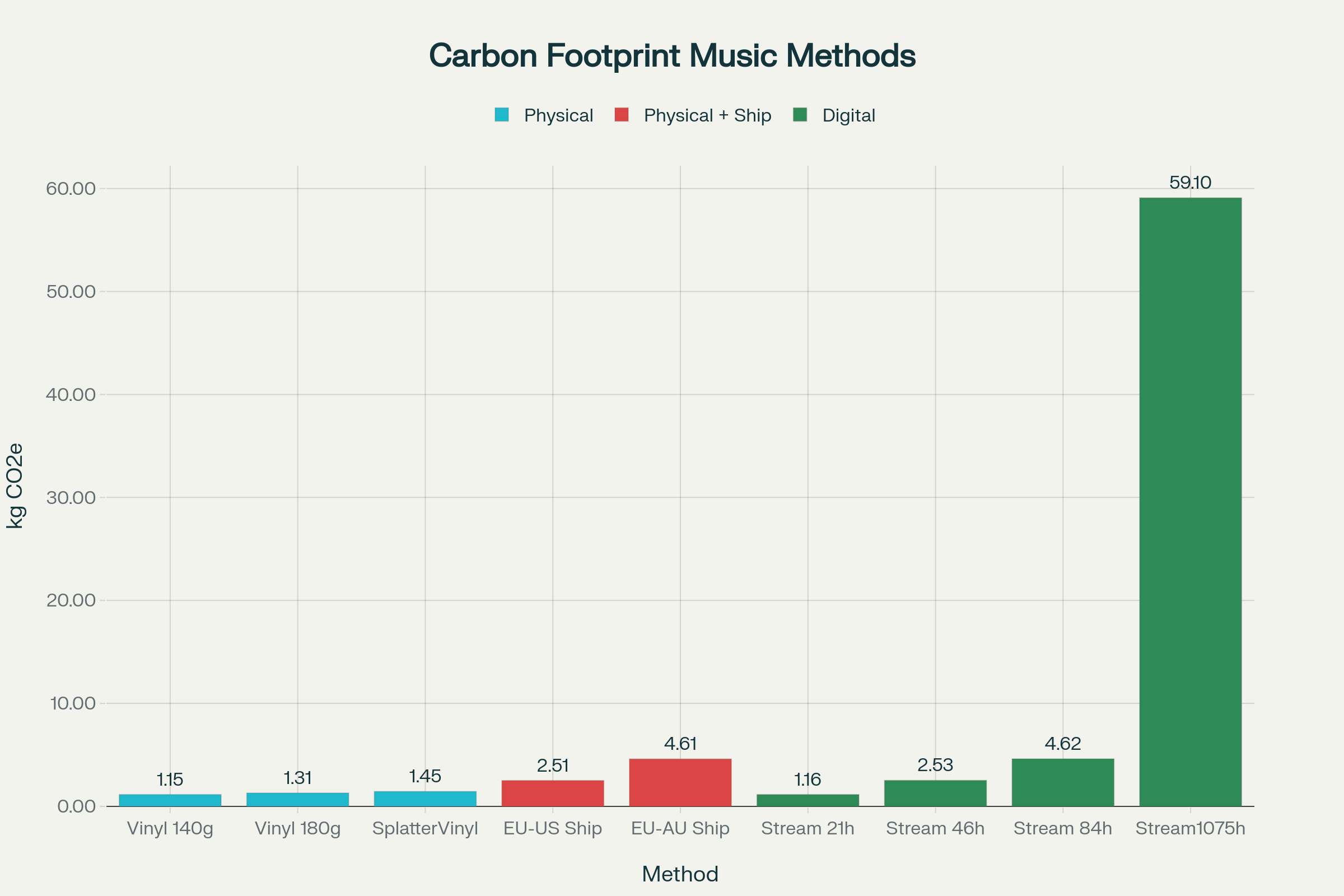
Environmental Comparison: Vinyl Records vs Music Streaming
The environmental debate between vinyl records and music streaming is more nuanced than it initially appears. While streaming seems cleaner due to its digital nature, the reality involves complex trade-offs between upfront emissions and cumulative energy consumption.
Carbon Footprint Analysis
Vinyl Records Environmental Impact
A standard 140-gram vinyl record generates approximately 1.15 kg of CO2 equivalent emissions during its “cradle-to-factory gate” production phase. This footprint breaks down as follows:
- PVC compound: 50% of emissions (0.575 kg CO2e)
- Energy consumption: 30% of emissions (0.345 kg CO2e)
- Print packaging: 13% of emissions (0.150 kg CO2e)
- Other processes: 7% of emissions (lacquers, cutting, stampers)
Heavier vinyl variants significantly increase emissions – 180-gram records produce 14% more emissions (1.31 kg CO2e), while specialty splatter vinyl can increase emissions by up to 26% (1.45 kg CO2e).
Music Streaming Environmental Impact
Music streaming generates approximately 55 grams of CO2 equivalent per hour of listening. This may seem minimal, but the cumulative effect is substantial given modern consumption patterns:
- Average listeners stream 20.67 hours per week
- Annual streaming totals approximately 1,075 hours
- This results in 59.1 kg CO2e per year for the average listener
The emissions stem from data centers, transmission networks, and user devices required to deliver digital music. Data centers alone are responsible for roughly 3% of global greenhouse gas emissions, comparable to the airline industry.

Carbon footprint comparison between vinyl records and music streaming across different scenarios
The Break-Even Point
The critical finding is that vinyl and streaming have a break-even point at approximately 21 hours of listening. This means:
- If you listen to an album fewer than 21 times, streaming is more environmentally friendly
- If you listen to an album more than 21 times, vinyl becomes the greener option
- For frequent listeners who play the same albums repeatedly, vinyl offers better long-term environmental efficiency
Shipping and Global Distribution
Shipping dramatically affects vinyl’s environmental footprint. Air freight adds substantial emissions:
- Europe to America: Additional 1.36 kg CO2e per record
- Europe to Australia: Additional 3.46 kg CO2e per record
When shipping is included, the break-even point shifts significantly – a vinyl record shipped by air from Europe to the US requires 46 hours of streaming to match its emissions.
Industry Scale and Growth Trends
The scale of both industries amplifies their environmental impact:
Vinyl Industry:
- Nearly 50 million vinyl records sold in 2023
- Estimated 23,750 tons of CO2 emissions from vinyl production alone
- Vinyl sales continue growing, with 2021 seeing the biggest sales week since 1991
Streaming Industry:
- Over 4 trillion songs streamed in the US in 2023
- Music streaming emissions estimated at 200-350 million kg CO2 annually in the US alone
- Spotify alone is projected to emit 187,040 tonnes of CO2e in 2025
Sustainability Improvements
Both industries are pursuing environmental improvements:
Vinyl Sustainability Initiatives:
- Bio-attributed PVC compounds can reduce footprint by 44%
- Switching to renewable energy at pressing plants
- Minimizing packaging and avoiding heavy weights
- Using 140g instead of 180g+ vinyl reduces emissions
Streaming Sustainability Efforts:
- Data centers increasingly powered by renewable energy
- Energy-efficient coding and protocols
- Green CDN solutions to reduce transmission distances
- Downloads vs streaming can reduce emissions by 80%
Consumer Behavior Considerations
The environmental impact also depends on consumption patterns:
- Casual listeners who sample many different songs benefit from streaming’s efficiency
- Dedicated fans who repeatedly play favorite albums should consider vinyl
- Collectors buying vinyl primarily for ownership rather than repeated listening create unnecessary emissions
- Digital downloads offer a middle ground – initial energy cost but no repeated streaming emissions
Key Recommendations
For Environmentally Conscious Music Lovers:
- Download frequently played music rather than repeatedly streaming it
- Choose vinyl for albums you’ll play 20+ times
- Stream for discovery and casual listening
- Buy vinyl locally to avoid shipping emissions
- Choose 140g over heavier vinyl variants
- Avoid multiple vinyl variants of the same album
The Verdict:
Neither vinyl nor streaming is categorically “greener” – it depends entirely on listening habits. For casual, diverse music consumption, streaming wins. For dedicated listening to favorite albums, vinyl becomes more sustainable after the 21-hour break-even point. The key is matching your consumption method to your actual listening patterns rather than choosing based on perceived environmental friendliness.
The most sustainable approach combines both formats strategically: streaming for discovery and variety, vinyl for treasured albums you’ll play repeatedly, and digital downloads for moderately played favorites. This hybrid approach optimizes environmental impact while preserving the benefits of each format.








